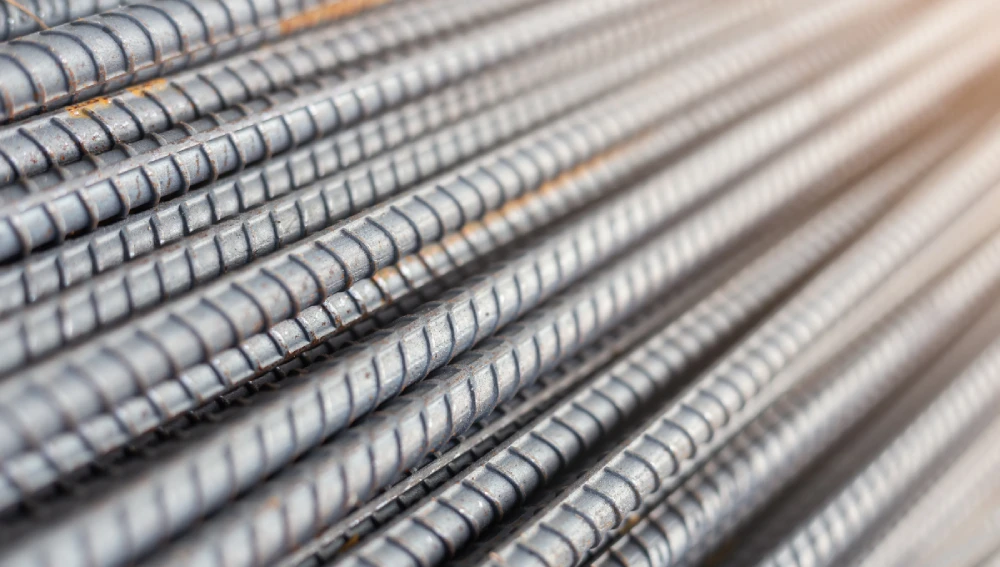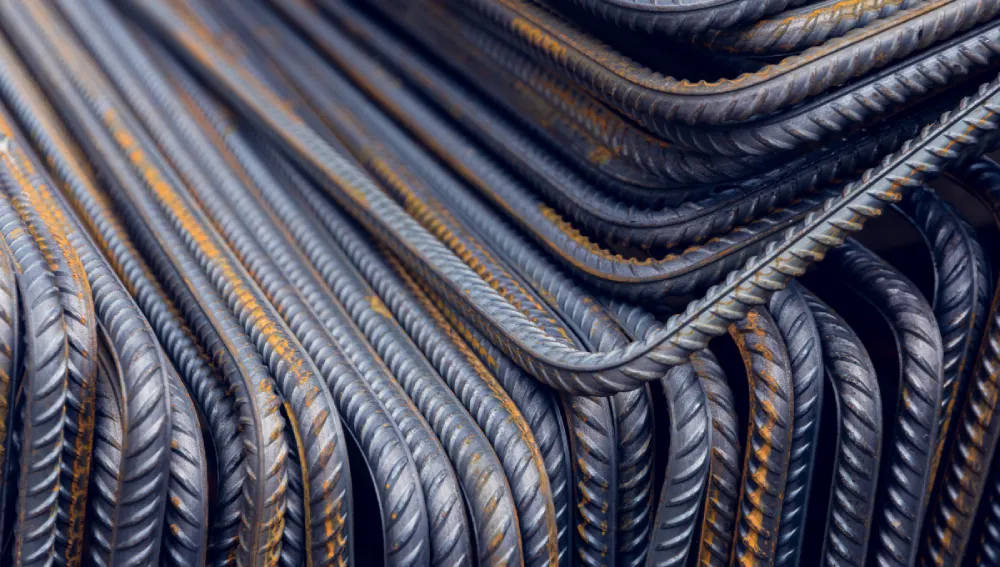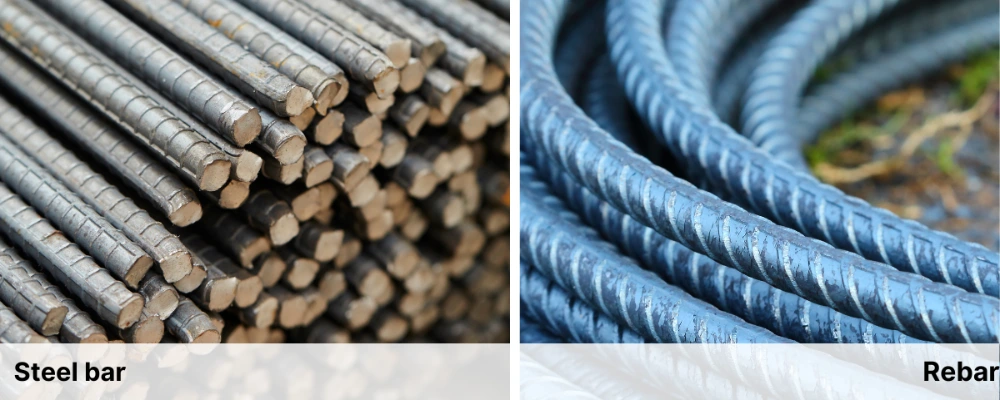There are different types of steel that play a distinct role in construction.
Steel bars are commonly used to enhance the strength of concrete, and rebars are used to increase the tensile strength by blending with concrete.
This blog helps you to understand the difference between steel bars and rebars, hence making you an expert in your building construction.
Steel Bars

A steel bar is a blend of carbon and iron that is specifically used in construction where heavy structures are necessary. The general composition of steel bars varies depending on their property and usage in the buildings.
Iron, which is chemically known as Fe, constitutes around ninety-six percent to ninety-nine percent of the total fundamental design.
The durability and strength of the steel vary depending on the composition of the steel. The general composition of carbon in a steel bar ranges from 0.02 percent to 2.1 percent.
Applications of Steel Bar
The utilisation of steel bars is infinite, and some of their uses are explained below:
- Steel bars are primarily used in construction works to that withhold the foundations and bear the structural elements.
- Steel bars are used in the production of different machine parts, namely gears and tools.
- Additionally, they are used in shipbuilding and automotive industries.
- As steel bars can withstand heavy weights and are durable, they are used in the construction of bridges and railways.
- Steel bars are also used in the oil and gas industries in drilling rings, pipelines, and other transportation services in the field.
- They are also used in the manufacture of defence products and in the aerospace industry. In defence, they are used in the production of weapons, vehicles, and protective equipment.
- In the aerospace industry, steel plays a significant role in manufacturing light-weight and high-strength materials.
Rebar

A rebar is also known as a reinforcing bar. It is widely used in reinforced concrete structures and provides strength to the building. When concrete is stretched, the strength of the concrete reduces, and rebars are introduced to withstand the tensile forces.
This blend of rebars and concrete provides a durable product known as reinforced concrete that is widely used in construction.
The composition of a rebar differs depending on the carbon amount; however, alloys also play a crucial role in determining the strength of the material depending on its utility.
The carbon steel Iron contributes around ninety-six to ninety-eight percent of the fundamental strength, and carbon contributes between 0.2 and 0.5 percent. However, depending on the usage, manganese, sulphur, phosphorus, silicon, vanadium, and nickel are used in different compositions.
Applications of Rebar
As rebars increase the tensile strength of the concrete, they are used in a wide range of applications that are listed below:
- Rebars in construction provide structural integrity and increase the load-bearing capacity, making them a perfect solution for industrial buildings, floors, roofs, and residential buildings.
- Reinforced concrete columns are widely used to bear loads above the floors and withstand high tensile strength. They are used in the construction of bridges.
- Rebar slabs allow distribution of weight evenly, thus preventing cracks. Hence, they are used in industrial and residential flooring.
- Rebars can withstand ground pressure and environmental forces and are used in the construction of tunnels.
- Rebars are often used in nuclear power plants to contain nuclear reactions and to ensure cooling of the towers.
Differences Between Steel Bar and Rebar
There are significant differences between steel bars and rebars, as listed below:
| Properties | Steel Bars | Rebars (Reinforced Bars) |
| Definition | Steel bars are rigid metal rods that are a blend of alloys of carbon, and iron. | Rebars are steel bars that when mixed with concrete provides reinforced concrete that has high tensile strength. |
| Composition | They are primarily made of steel or stainless steel. | They are made of carbon steels with certain patterns in the surface layer to be able to blend with concrete. |
| Texture | The surface can be smooth or polished depending on the application. | They are twisted or have patterned ridges to provide binding of concrete. |
| Purpose | They are widely used for manufacturing, construction, and in machine components. | The main purpose is to add strength to the concrete. |
| Strength | The tensile strength of the steel bars differs depending on the grade. | The rebars offer high tensile strength so that the concrete can withstand breaking. |
| Ductility | Depending on the composition and application the ductility may differ. | They have high ductility and can prevent any cracks and tears. |
| Process of Manufacturing | Depending on the application the manufacturing process can be cold rolling, drawing, orhot rolling. | They normally undergo hot rolling as they need to be twisted into a shape. |
| Size and Shape | They are available in different sizes depending on the application and can be hexagonal, square, or round in shape. | The usual shape of a rebar is round with a standard diameter from 6 mm to 50 mm. |
| Cost | The pricing may differ depending on the size, shape, type of alloy, and in common they are expensive. | The price primarily differs on the coating material that is used and is generally cost-effective. |
Conclusion
In summary, both reinforced bars and steel bars have significant roles in construction with distinct applications. The steel bars are normally alloys of carbon and iron and play a crucial role in building and in marine operations. However, the rebars, also known as reinforcement bars, are primarily used along with concrete. They provide tensile strength and reduce cracks in concrete.Hence, it is crucial to select the steel bars depending on your application.
FAQs
The primary use of steel is in the construction of industrial buildings, residential areas, and in the construction of underground pipes.
A rebar is often called a reinforced bar that is primarily used along with concrete to increase the tensile strength.
While steel bars are strong, they are not specifically designed to bond with concrete like rebars. Rebars have surface patterns that ensure a better bond with concrete, making them more suitable for reinforcement. Using steel bars instead of rebars could compromise the structural integrity of concrete.
Rebar strength is also measured by tensile strength, which is particularly important for reinforcing concrete. Rebars are designed to handle tension forces that concrete alone cannot withstand. This makes them essential for ensuring the structural integrity of concrete.
Rebars are typically produced through hot rolling, followed by additional processing to create surface patterns. This process ensures that rebars have the necessary strength and bonding characteristics for reinforcing concrete. The hot rolling process also allows for the production of various sizes and shapes.
Rebars are generally more affordable, especially when considering their vital role in reinforcing concrete structures. The price of rebars can vary depending on the coating and material used. However, their contribution to the structure’s longevity and safety makes them a wise investment.
Rebars are generally more affordable, especially when considering their vital role in reinforcing concrete structures.

